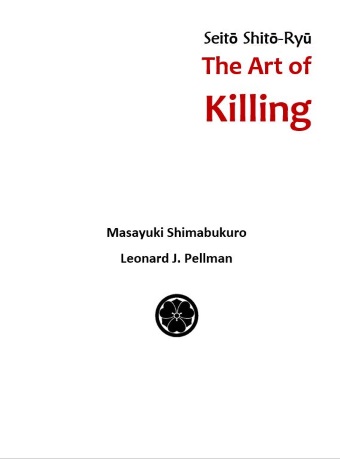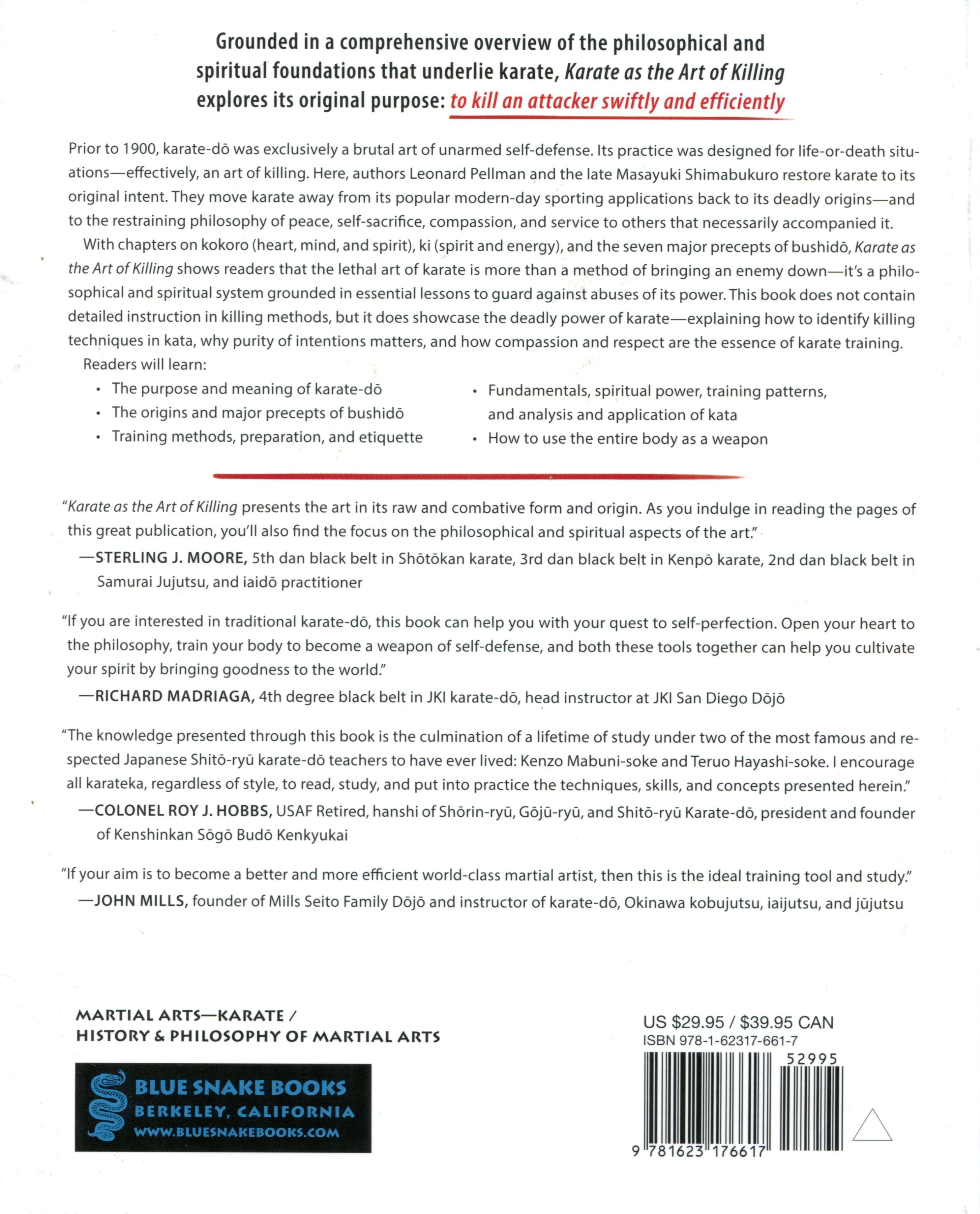The Art of Killing
 Hanshi
not only wanted to take the book in a new direction in
techniques, training emphasis, and philosophy, he also
had a specific idea in mind for its cover. With
hundreds of books on karate already in
print, Hanshi wanted The Art of Killing
to stand out visually from all the rest. The
majority of existing books on karate either feature a
cover image of one or more people performing karate
techniques or an image that evokes the art's Japanese
origins, like bamboo, tatami, or an ancient dōjō or
temple. Many also use bright colours on their covers to
attract attention. So Hanshi wanted to use the
opposite tactic—a cover in plain, stark white with "The
Art of Killing" in bold, blood-red
letters. Hanshi's favourite of the several mock-ups Pellman
Shihan created for his review is shown at left.
Hanshi
not only wanted to take the book in a new direction in
techniques, training emphasis, and philosophy, he also
had a specific idea in mind for its cover. With
hundreds of books on karate already in
print, Hanshi wanted The Art of Killing
to stand out visually from all the rest. The
majority of existing books on karate either feature a
cover image of one or more people performing karate
techniques or an image that evokes the art's Japanese
origins, like bamboo, tatami, or an ancient dōjō or
temple. Many also use bright colours on their covers to
attract attention. So Hanshi wanted to use the
opposite tactic—a cover in plain, stark white with "The
Art of Killing" in bold, blood-red
letters. Hanshi's favourite of the several mock-ups Pellman
Shihan created for his review is shown at left.
Work on The Art of Killing was sporadic in 2010 and 2011, in part because Pellman Shihan was living in Indiana and Shimabukuro Hanshi in California, so their communication was almost entirely by phone and email. In addition, Pellman Shihan's mother died in 2010, leaving a complicated estate that took him nearly two years to settle as her executor. He also underwent two major job changes that disrupted his life considerably.
At the same time, but unknown to Pellman Shihan, Shimabukuro Hanshi was battling gall bladder cancer which eventually spread to his liver. Neither co-author was functioning at full capacity, nor able to devote their undivided attention to The Art of Killing. Just before Christmas in 2011, Pellman Shihan was notified that his entire department at the university was being eliminated and his employment would be terminated on 30 June 2012. Over the next six months, Pellman Shihan submitted more than 200 job applications to colleges, universities, businesses within a 500 mile radius of his home in Indiana and traveled to more than 50 interviews, only to be told he was too old, over-qualified, or the wrong ethnicity for those positions. In late March, Pellman Shihan called to wish Hanshi a happy birthday. During that call, Hanshi revealed that he had been battling gall bladder cancer for over a year, but he had recently undergone surgery to remove the gall bladder and he was confident he would soon be fully recovered.
Having still received no feasible employment offers, Pellman Shihan put his house up for sale in May 2012 and began preparing for an interstate or international relocation. In July 2012, with no day job to consume the majority of his workday, Pellman Shihan threw himself into work on The Art of Killing. It served as a welcome distraction from his uncertainty over finding employment and a new home. He was quickly able to complete work on three chapters that had been languishing for months, and emailed them to Shimabukuro Hanshi. The call he received a few days later was devastating.
"I'm dying, Len-san," Hanshi told him. "The cancer spread to my liver and is inoperable. You'll have to finish the book yourself."
After the initial shock, Pellman Shihan felt strongly motivated to finish the book as quickly as possible out of a sense of duty to Hanshi and to honour Hanshi's memory. By mid-1012, the entire book had been outlined, eight or nine chapters completed, five or six more chapters partially complete, and extensive notes compiled on the remaining chapters. All the information needed to finish the book was in his hands, but every time he started to work on it, Pellman Shihan grew deeply depressed. Much later he realised that subconsciously he didn't want to finish the book, because it would end his interaction with Hanshi. So progress was slow and painful. In April 2013, Pellman Shihan's house sold and he moved to Texas the following month. The Art of Killing was packed in a box, where it reamined for several more years ...
It wasn't until he was persuaded to update Flashing Steel for its 25th Anniversay Edition in 2019 that Pellman Shihan seriously considered completing The Art of Killing. Whilst digging through cartons of memorabilia for the tribute to Shimabukuro Hanshi, he came across his folders of handwritten notes for The Art of Killing. Having suffered multiple heart attacks, bypass surgery, and kidney failure in recent years, he realised that he may have little time left in which to complete the book, and by doing so complete Hanshi's written legacy. The rest of the story is told in the introduction and afterword of the book.
Due to a quirk in the way book titles are now indexed and stored in computer databases, the publisher decided that the title should be Karate as the Art of Killing to ensure that it would be classified as a book on karate and martial arts.
A Peek Inside ...
 Coming
Soon! We will soon add a few sample pages and/or
excerpts from Karate as the Art of Killing here.
Coming
Soon! We will soon add a few sample pages and/or
excerpts from Karate as the Art of Killing here.
More about the content of Karate as the Art of Killing will be explained in this section.
Where to Buy Karate as the Art of Killing
 Online
Bookstores: Karate as the Art of
Killing is available from major online
bookstores, including:
Online
Bookstores: Karate as the Art of
Killing is available from major online
bookstores, including:
•
Amazon (Both print and Kindle editions available)
•
Barnes & Noble (Both print and
Nook editions available)
Used Bookstores:
Copies of Karate as the Art of Killing are not
currently
available, but will become
available in the near future
from online used book sellers like:
•
Thriftbooks
•
Abe Books
Seishin-Kan Online Store: print editions autographed by co-author, Leonard J. Pellman can be purchased (when in stock) from our own online store.
In Person: print editions autographed by co-author, Leonard J. Pellman can also be purchased in person at any regularly scheduled class at Victory Dōjō or any of Pellman Shihan's seminars or public appearances.

